Catalog Ads in bottom-funnel ads and retargeting
May 8, 2025
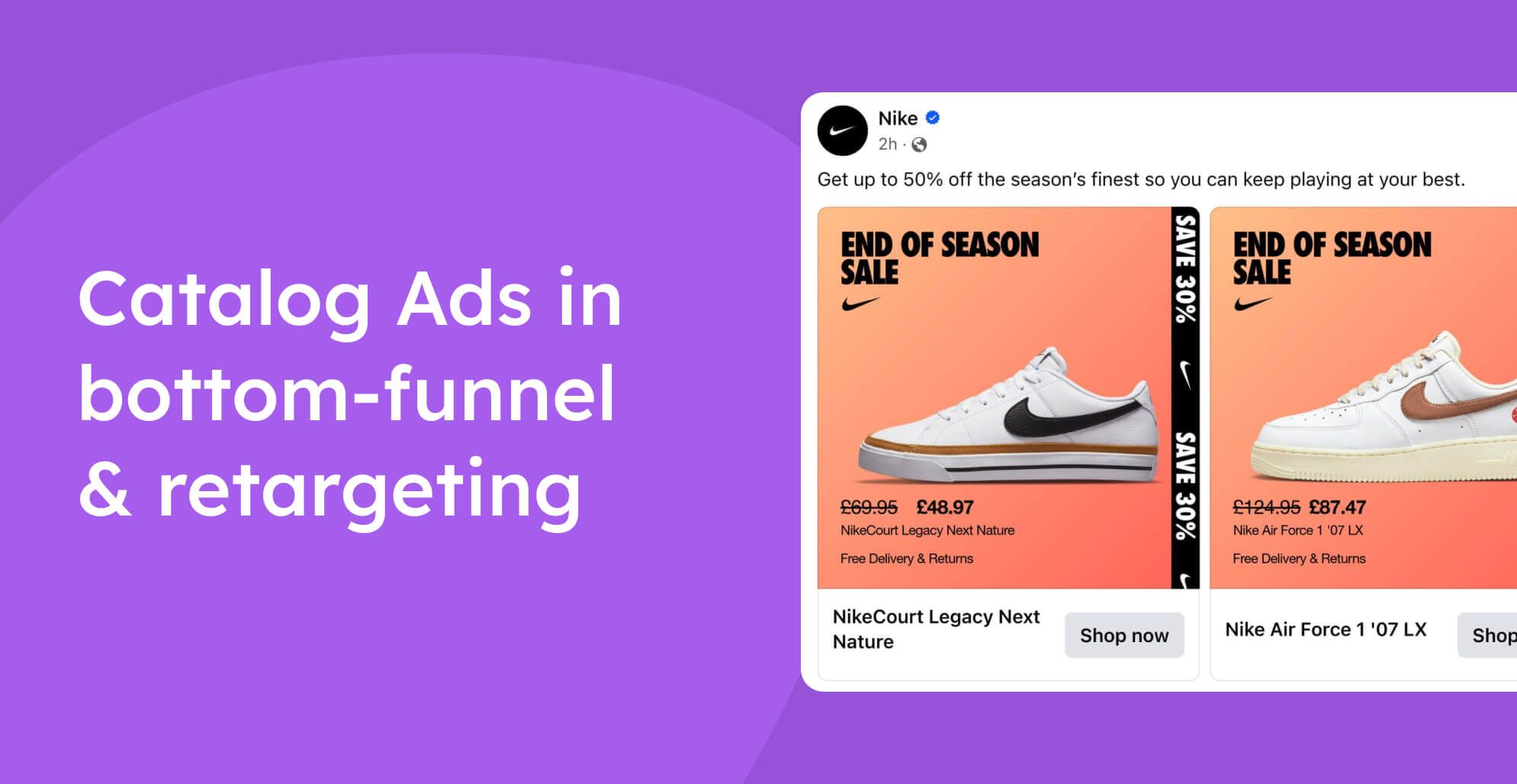
Are you looking to improve the performance of your bottom-funnel and retargeting Catalog Ads?
In this guide, we'll share data-driven strategies to help you optimize your ads for higher conversions and better Return on Ad Spend (ROAS).
We've analyzed thousands of Catalog Ads across millions of impressions to identify the most effective tactics for bottom-funnel and retargeting campaigns.
From displaying prices and promotions in your ads to integrating social proof, we'll discuss a range of strategies that can make a real difference in your ad performance.
If someone’s already visited your website or clicked one of your ads, they’re not a stranger. They know your brand, they’ve seen your products, and they might just need a small nudge to buy. That’s where bottom-funnel and retargeting Catalog Ads come in.
At this stage, it’s not about building awareness. It’s about sealing the deal.
And there's a good reason to use Catalog Ads for this - look at how effective Catalog Ads are in the bottom funnel, compared to normal manual ads:
| Performance of bottom-funnel ads | Normal ads | Catalog Ads |
|---|---|---|
| ROASReturn On Ad Spend | baseline | +107% |
| CPACost Per Purchase | baseline | -39% |
| CTRClick Through Rate | baseline | +50% |
This article outlines the specific design elements that can make your Catalog Ads more effective for people who are already interested. Things like showing prices, discounts, or even social proof might seem small, but they can have a big impact when someone’s close to converting.
The goal? Help you get more sales and better ROAS without needing to guess what to try next.
This isn’t just a list of tips – we'll also explain the psychology behind why these strategies work so well for shoppers close to making a purchase.
Bookmark this page by pressing ctrl + D / cmd + D, or by clicking the star icon in your URL bar ⭐️.
Here you have the insights in a quick cheat sheet - click to get more details:
The most used product fields in Catalog Ads designs:
The moderately used product fields in Catalog Ads designs:
The rarely used product fields in Catalog Ads designs:
This isn’t just a list of things to add to your ads. We’ll explain why each tactic works and when it makes the most sense to use it, so you can design smarter ads for people who are already halfway to clicking “buy.”
Let’s get into it!
Showing Prices in your Catalog Ads
Price matters, especially when someone’s close to making a purchase. At the bottom of the funnel, shoppers are already familiar with your product. Now they just want to know: How much is it? Catalog Ads that include pricing at this stage see a +54% boost in ROAS and a +19% jump in conversion rates.
The lower your customer is in your marketing funnel, the better Catalog Ads with prices typically perform compared to Catalog Ads without prices.
- Top-funnel ads see a +31% improvement in Return on Ad Spend when showing prices
- Bottom-funnel ads see a +54% improvement in Return on Ad Spend when showing prices
This data shows that when customers are close to making a purchase decision, they’re highly interested in specific details, including the price. Displaying the price in your bottom-funnel Catalog Ads provides shoppers with key information for completing their purchase.
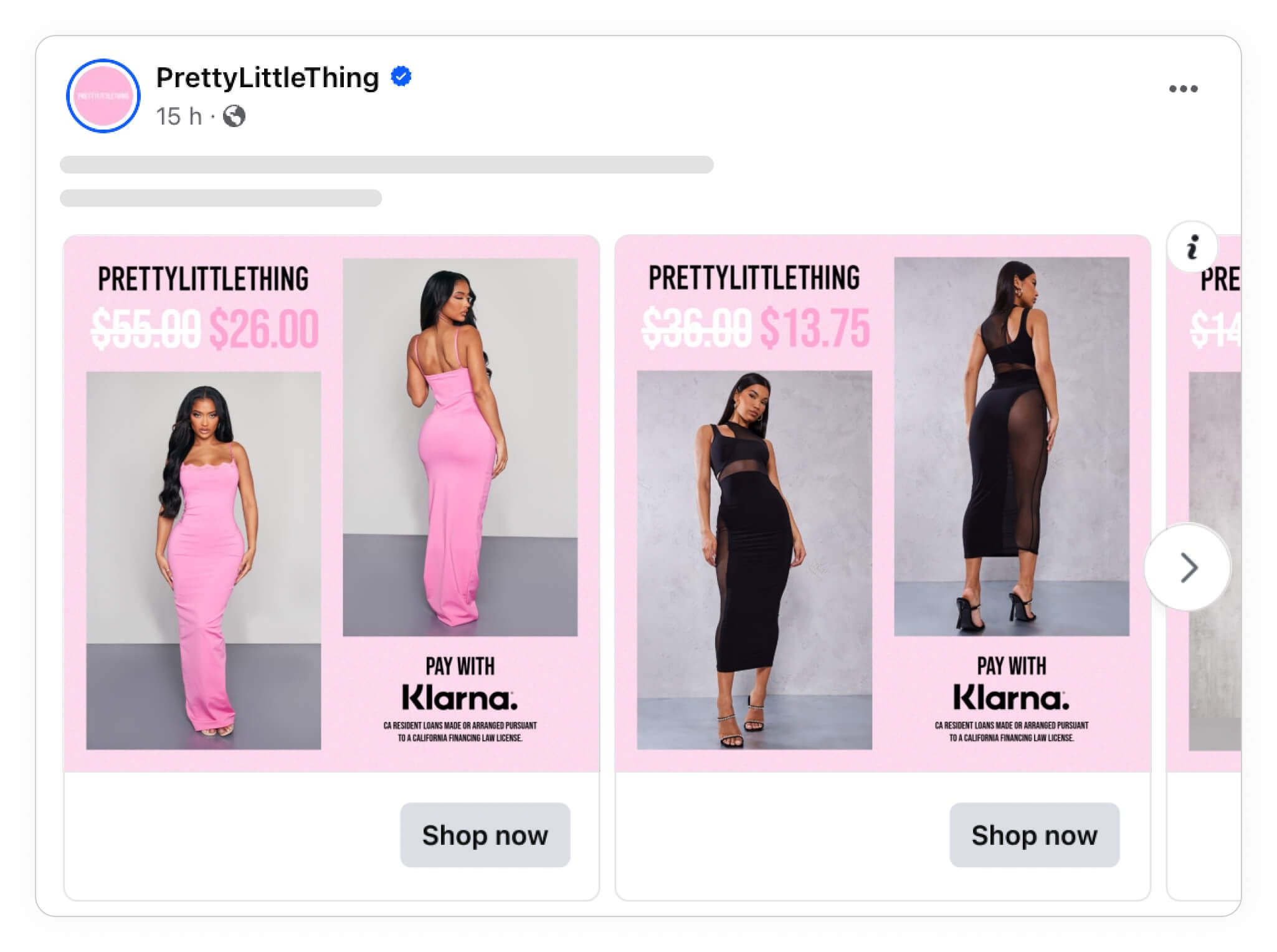
Why does it work? Because it builds trust. Being upfront about cost removes friction and gives shoppers the info they need to make a decision right then and there. It also helps qualify leads; people clicking through already know what to expect, which can save you ad spend in the long run.
Still, it’s not one-size-fits-all. If your price point is higher than your competitors, it might turn some shoppers away. That’s why design matters: pairing the price with strong value cues (like reviews, USPs, or discounts) helps justify the cost.
Keep it clean, keep it clear, and avoid cramming too much in.
You can learn more about showing prices in your Catalog Ads right here.
Here's how showing prices on average influence Catalog Ads:
Return On Ad Spend
+54%
Cost Per Purchase
-7%
Click Through Rate
-11%
Cost Per Click
+8%
Conversion Rate
+19%
Usage
49%
These numbers show how Catalog Ads showing prices perform on average compared to Catalog Ads not showing prices.
Remember that these are average numbers. For some brands, prices perform better, and for other brands, prices perform worse.
Advantages of showing prices in bottom-funnel Catalog Ads:
Helps qualify leads by ensuring the customer is comfortable with the price point before they click through.
Builds trust and transparency with shoppers already familiar with your brand.
Streamlines the purchase process by addressing a key question (what’s the price?) upfront, reducing friction.
Disadvantages of showing prices in bottom-funnel Catalog Ads:
May discourage price-sensitive shoppers if your prices are higher than competitors.
Risks cluttering the ad with unnecessary information.
Could put people off by drawing attention away from the product’s features.
Display clear, visible prices in bottom-funnel ads to help shoppers feel informed and ready to buy. Avoid clutter – keep the focus on essential product details alongside the price for a clean, effective presentation.
You can learn more about showing prices in your Catalog Ads right here.
Showing your Logo in Catalog Ads
Your logo might not steal the spotlight, but in bottom-funnel ads, it plays a quiet yet important role. While it doesn’t boost performance dramatically, it still delivers a +14% ROAS increase in retargeting campaigns. For shoppers who already know your brand, that visual reminder can nudge them closer to buying.
Showing your logo in Catalog Ads typically doesn't improve the performance, but we do see some small changes to this based on your audience. The further down in your funnel you are, the more your logo will typically help close the sale.
- Top-funnel ads, on average, don't see improvements in Return on Ad Spend when showing your logo
- Bottom-funnel ads see a +14% improvement in Return on Ad Spend when showing your logo
The numbers are modest. However, it appears that the further down a customer in your funnel is, the more impact your logo might have on closing the sale.
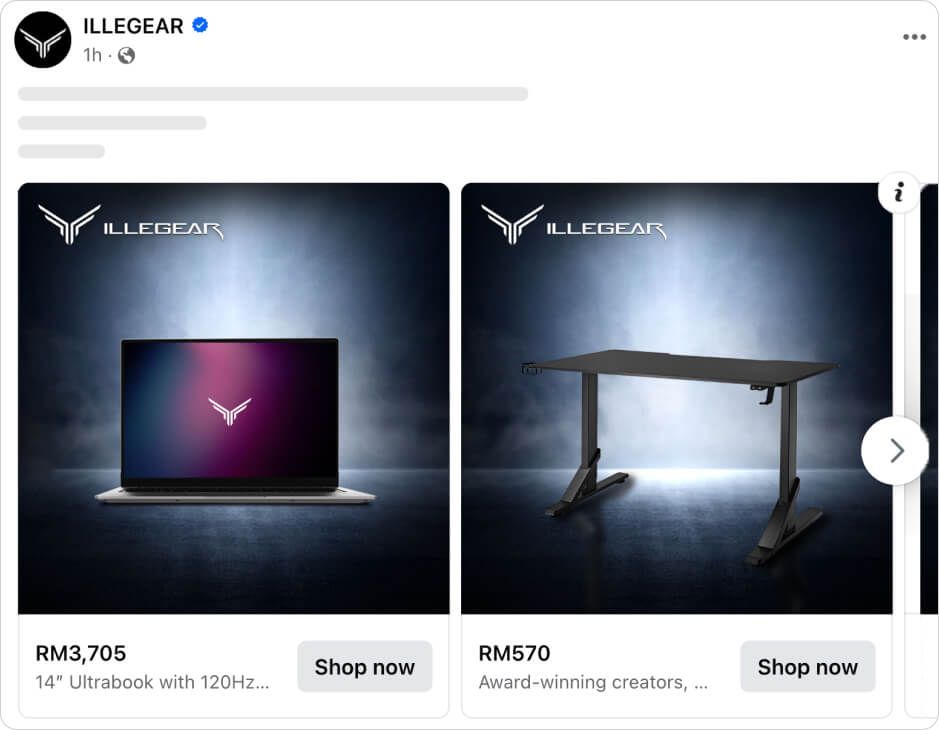
Logos help with instant recognition. A quick glance tells people, Oh right, I’ve seen this brand before. That subtle familiarity builds confidence and trust, especially if your logo is tied to quality or a great past experience.
However, it’s easy to overdo it. If your logo is too large or placed awkwardly, it can distract from the product or price—two things that matter more at this stage. And if someone doesn’t know your brand yet, the logo alone won’t move the needle.
Here's how showing your logo on average influence Catalog Ads:
Return On Ad Spend
+14%
Cost Per Purchase
+2%
Click Through Rate
-1%
Cost Per Click
+13%
Conversion Rate
-7%
Usage
38%
These numbers show how Catalog Ads showing the logo of the advertiser perform on average compared to Catalog Ads not showing the logo.
Remember that these are average numbers. For some brands, their logo perform better, and for other brands, their logo perform worse.
The key is balance. Use your logo to enhance the ad, not dominate it. Think of it as a quiet signature, not a shout.
Advantages of highlighting your logo in bottom-funnel Catalog Ads:
Strengthens brand recognition and familiarity, increasing shopper confidence.
Enables shoppers to rapidly identify products from trusted brands.
Functions as a visual cue, creating positive brand associations.
Disadvantages of incorporating your logo in bottom-funnel Catalog Ads:
Can shift focus away from important elements such as product images or calls-to-action.
Risk of overwhelming ad design if logo placement isn't strategic.
Reduced effectiveness for shoppers unfamiliar with your brand.
To optimize the impact of your logo in bottom-funnel Catalog Ads, consider opting for a subtle, space-saving logo placement that complements the overall ad design.
Experiment with various logo sizes, styles, and positions to determine the ideal configuration for your audience.
You can explore more insights on featuring your logo in Catalog Ads here.
Showing On-sale designs in your Catalog Ads
Few things grab attention like a good deal, and when someone’s already familiar with your brand, a sale might be all it takes to seal the deal. Bottom-funnel Catalog Ads that showcase discounted products see a +68% boost in ROAS and an 18% drop in cost per purchase. That’s massive.
Even though sales more often than not will perform better, then sales are especially effective in your bottom funnel and retargeting - making consumers that already know about you very likely to buy.
The more bottom-funnel your ad is, the better a sale will work.
- Top-funnel ads see a +39% improvement in Return on Ad Spend when showing on-sale designs
- Bottom-funnel ads see a +68% improvement in Return on Ad Spend when showing on-sale designs
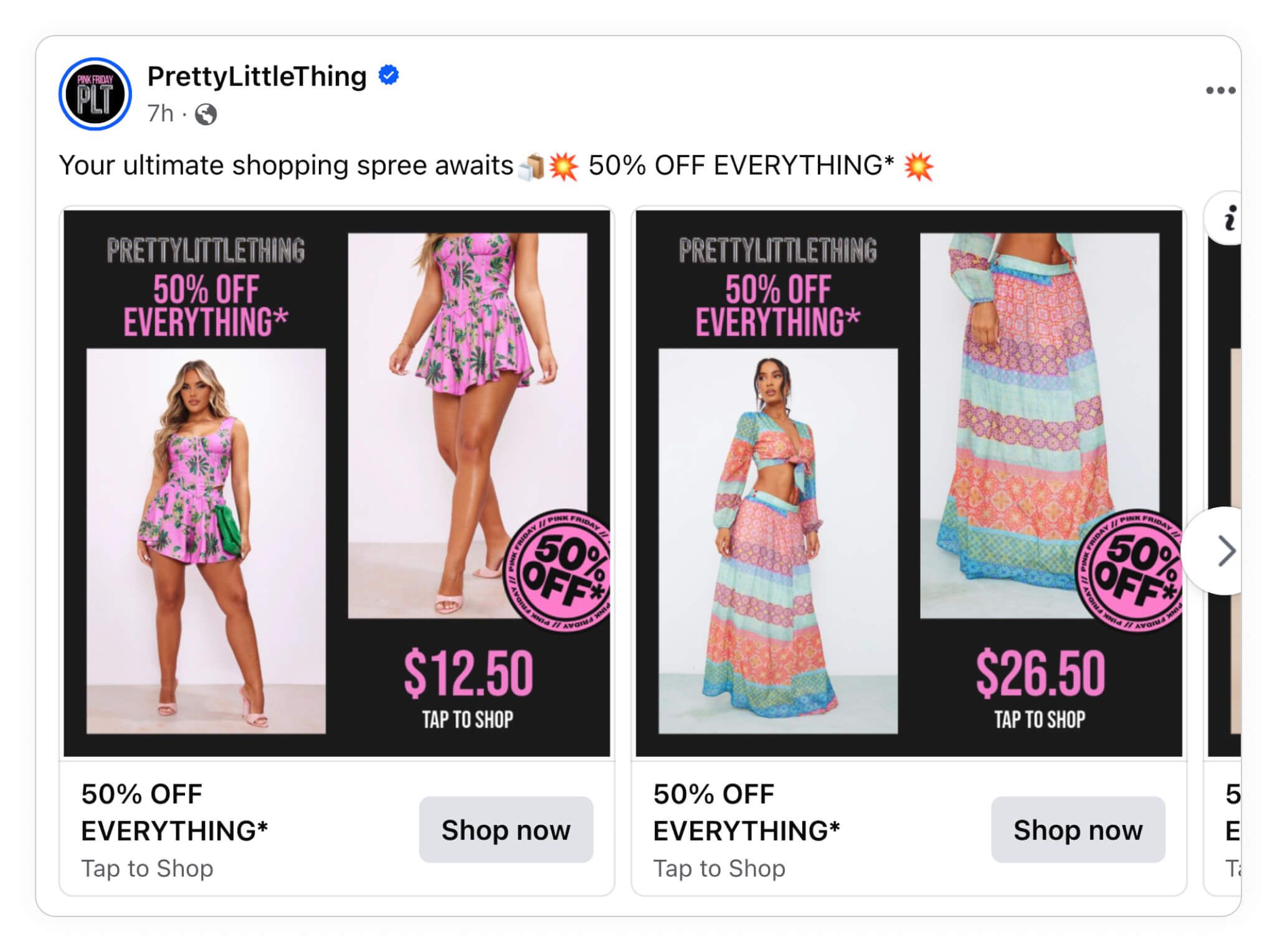
Why? Because these shoppers already know you. They’ve seen your products, maybe even considered buying before. Showing them a sale now gives them the perfect excuse to go for it.
The visual aspect matters here too: sales badges, percentage-off tags, and clear contrast between original and sale prices can help the discount stand out instantly. This works especially well for products that may have felt “just out of budget” the first time around.
Plus, sales messaging adds urgency. A limited-time offer or seasonal promotion can create the nudge someone needs to finally hit “Buy.”
Just make sure your layout stays clean. Too much going on can quickly drown out the deal itself.
You can see a ton of examples of sales Catalog Ads here, learn more about showing discounts in your Catalog Ads here, and learn more about campaigns in your Catalog Ads here.
Here's how showing on-sale designs on average influence Catalog Ads:
Return On Ad Spend
+68%
Cost Per Purchase
-18%
Click Through Rate
+9%
Cost Per Click
-17%
Conversion Rate
+5%
Usage
38%
These numbers show how Catalog Ads showing on-sale designs perform on average compared to Catalog Ads not showing on-sale designs.
Remember that these are average numbers. For some brands, on-sale designs perform better, and for other brands, on-sale designs perform worse.
See examples of on-sale designs in Catalog Ads →
Showing Product Names in your Catalog Ads
Product names do more than just label; they help shoppers recognize, recall, and reassure. Including product names in your Catalog Ads can lead to a +43% increase in ROAS and a +15% boost in conversion rate. That’s a strong signal that shoppers care about clarity when they're on the edge of a purchase.
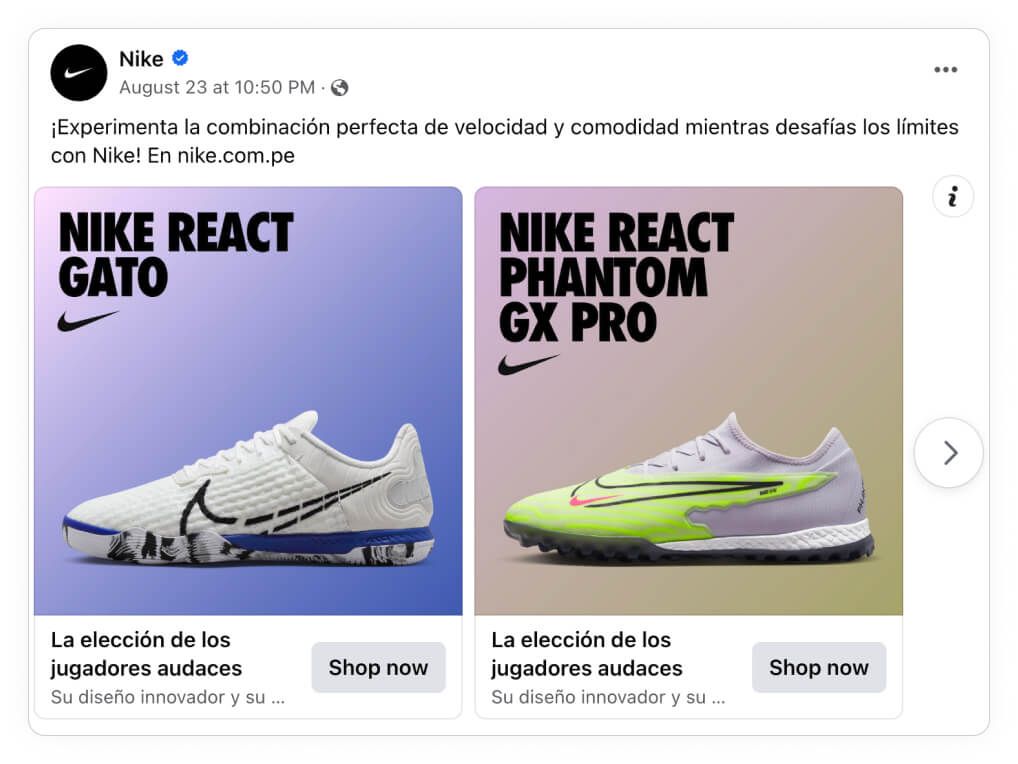
Think of product names as a bridge between interest and action. A name like “UltraSoft Cooling Sheets – Queen” gives more context than just an image. It reassures people they’re clicking on the exact item they want, especially if they’ve browsed it before.
They’re also great for search-style behavior. When shoppers are scrolling, product names can catch their attention like a headline, confirming the style, size, or color they’re looking for.
That said, not all product names are created equal. Overly technical or long names can clutter your ad or confuse shoppers. Keep them short, relevant, and readable for best results.
Here's how showing product names on average influence Catalog Ads:
Return On Ad Spend
+43%
Cost Per Purchase
-25%
Click Through Rate
+7%
Cost Per Click
+2%
Conversion Rate
+15%
Usage
38%
These numbers show how Catalog Ads showing product names perform on average compared to Catalog Ads not showing product names.
Remember that these are average numbers. For some brands, product names perform better, and for other brands, product names perform worse.
See more about showing product names in Catalog Ads →
Showing Original prices in your Catalog Ads
Displaying original prices, typically as a strike-through next to a sale price, can be a powerful motivator for shoppers. It taps into the psychology of perceived value and urgency. On average, including original prices leads to a +43% boost in ROAS, -17% drop in cost per purchase, and a +10% lift in CTR.
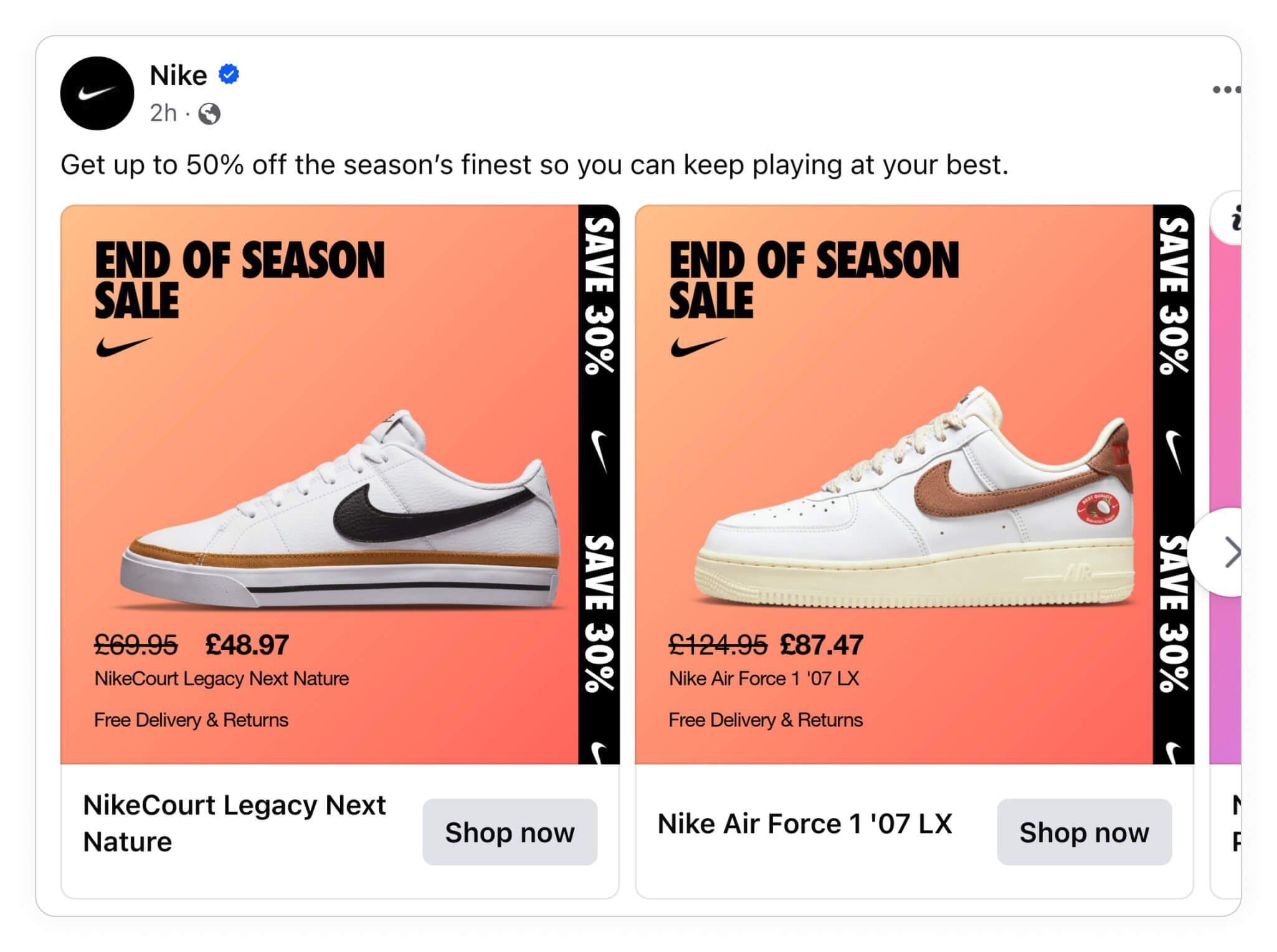
It works especially well in bottom-funnel ads, where shoppers are already considering a purchase. Seeing that a product was once $80 and is now $59 doesn’t just show savings. It justifies the buy. It makes people feel like they’re getting a deal they shouldn’t miss.
That said, conversion rates can actually dip for some brands (-19% on average) if the original price feels inflated or misleading. The key is to make the discount feel real—not forced. Too big of a gap, and it can hurt trust.
Use original prices in moderation, and test placements to ensure they enhance rather than distract.
Here's how showing original prices on average influence Catalog Ads:
Return On Ad Spend
+43%
Cost Per Purchase
-17%
Click Through Rate
+10%
Cost Per Click
-18%
Conversion Rate
-19%
Usage
25%
These numbers show how Catalog Ads showing original prices perform on average compared to Catalog Ads not showing original prices.
Remember that these are average numbers. For some brands, original prices perform better, and for other brands, original prices perform worse.
Explore more on using original prices in Catalog Ads →
Showing additional images in your Catalog Ads
When someone sees your product for the first time, too many visuals can feel overwhelming. But once they’re further down the funnel (when they’re already interested) additional images become a helpful tool, not a distraction. They add more context, show off different angles or uses, and help the shopper imagine owning the product.
When you introduce your products for consumers for the first time, you should not reveal too much information about the product. Don’t overwhelm a curios consumer with too many details - you can always do this later.
Additional images of the product is adding more details, in a visual way - and what we see, is that the lower in your funnel the consumer is, the better additional images work.
- Top-funnel ads see a +7% improvement in Return on Ad Spend when showing additional images
- Bottom-funnel ads see a +33% improvement in Return on Ad Spend when showing additional images
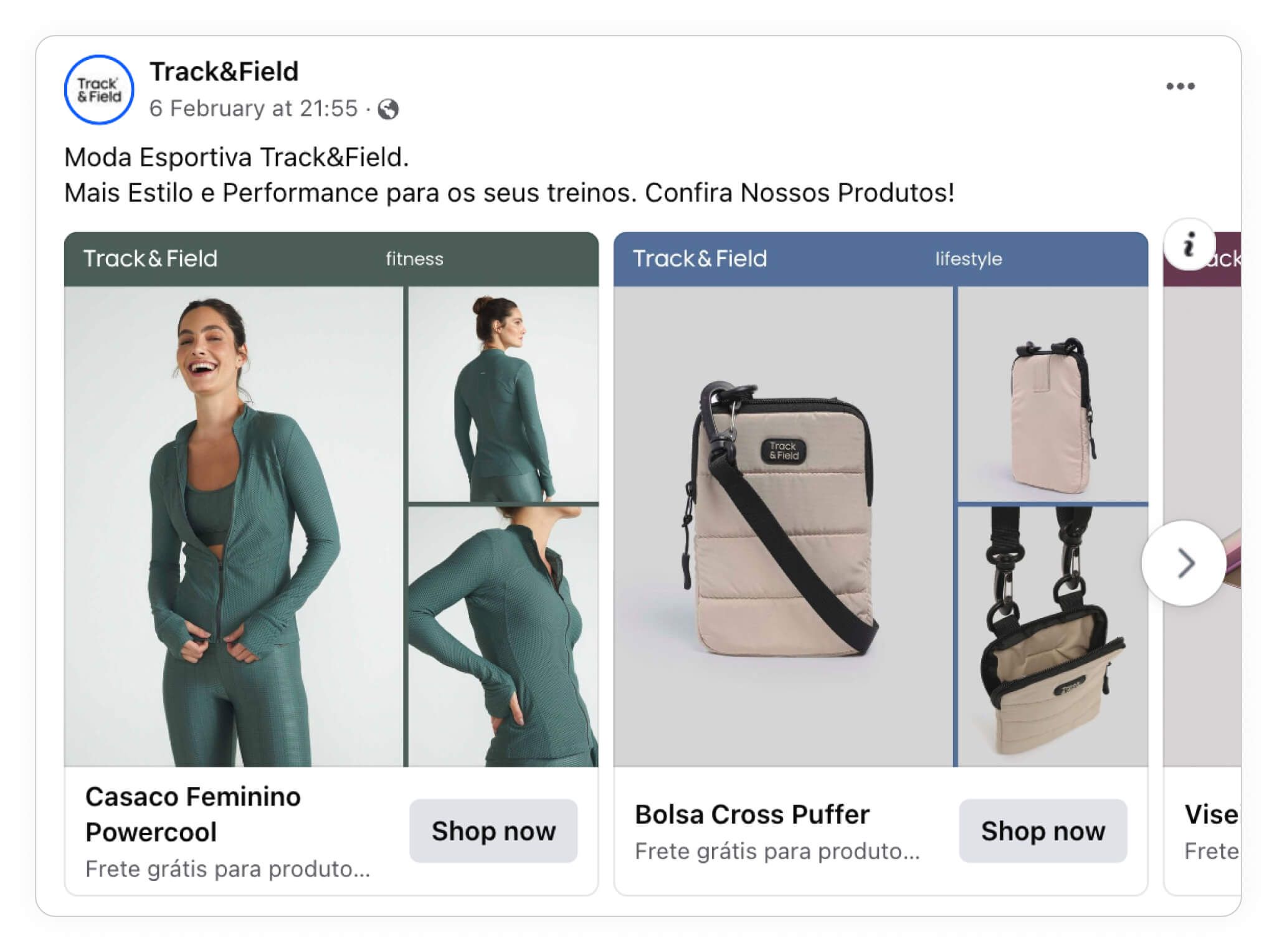
On average, bottom-funnel ads that include additional images see a +33% boost in ROAS, +26% lift in conversion rate, and +9% rise in cost per purchase. This suggests that while extra images may cost a bit more to convert, they also help seal the deal.
That said, keep your images relevant and purposeful. Avoid redundant angles or filler content. Every image should add something new or build desire. For products with features that aren’t obvious at first glance, this tactic can really pay off.
Don’t clutter your top-funnel ads, but down the line, use additional visuals to build confidence and drive conversions.
You can learn more about showing additional images in your Catalog Ads here.
Here's how showing additional images on average influence Catalog Ads:
Return On Ad Spend
+33%
Cost Per Purchase
+9%
Click Through Rate
-5%
Cost Per Click
+20%
Conversion Rate
+26%
Usage
21%
These numbers show how Catalog Ads showing additional images perform on average compared to Catalog Ads not showing additional images.
Remember that these are average numbers. For some brands, additional images perform better, and for other brands, additional images perform worse.
Learn more about using additional images in Catalog Ads →
Showing Savings and Discounts in your Catalog Ads
Shoppers love a good deal, and when they’re already close to buying, highlighting savings can be the final nudge they need. Showing how much a customer will save (not just the sale price) can create urgency, increase perceived value, and make the offer feel too good to pass up.
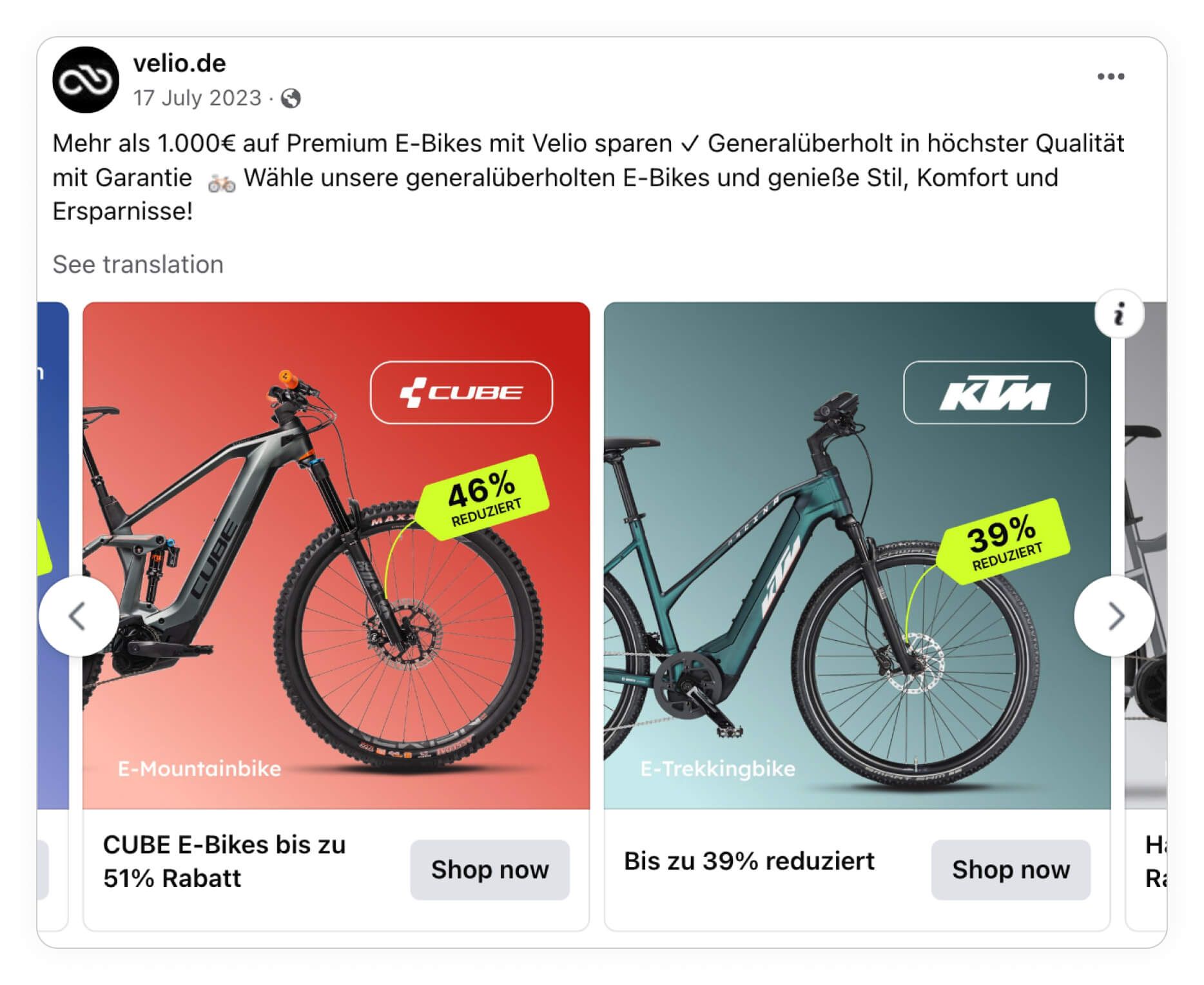
On average, Catalog Ads that showcase savings see a +105% boost in ROAS and a +35% increase in conversion rate, one of the strongest lifts across any tactic. This suggests that emphasizing the discount amount is often more persuasive than simply showing a reduced price.
It works especially well for bottom-funnel and retargeting audiences, who already know the brand and product. Seeing a limited-time discount can push them to act now, rather than wait.
Just be sure your savings are real and clearly communicated. Inflated or unclear discounts can create mistrust. But when done right, showing savings is one of the most powerful tools in your Catalog Ads toolbox.
Here's how showing savings on average influence Catalog Ads:
Return On Ad Spend
+105%
Cost Per Purchase
-3%
Click Through Rate
-7%
Cost Per Click
+1%
Conversion Rate
+35%
Usage
19%
These numbers show how Catalog Ads showing savings perform on average compared to Catalog Ads not showing savings.
Remember that these are average numbers. For some brands, savings perform better, and for other brands, savings perform worse.
Learn more about showing savings in Catalog Ads →
Showing Dates in your Catalog Ads
Adding a date, whether it’s a sale deadline, shipping window, or product release, can give your Catalog Ads a subtle but strategic lift. While not the most dramatic performance driver, showing dates still leads to a +12% increase in ROAS and a +16% boost in conversion rate on average.
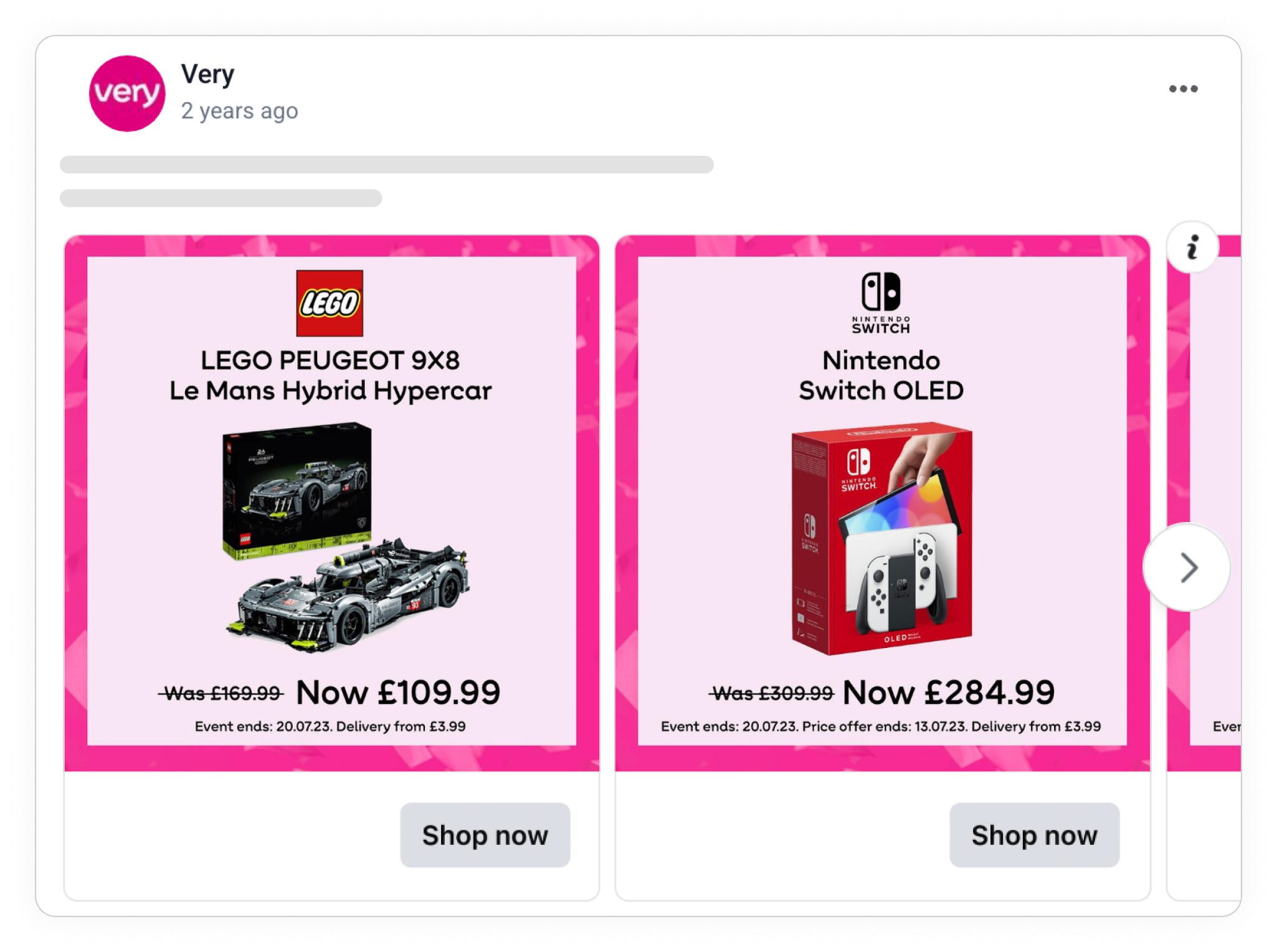
Here's how showing dates on average influence Catalog Ads:
Return On Ad Spend
+12%
Cost Per Purchase
-2%
Click Through Rate
-4%
Cost Per Click
+11%
Conversion Rate
+16%
Usage
25%
Dates help set expectations and add urgency. For shoppers deep in the funnel, knowing when they can expect delivery or how long a discount will last can make the difference between buying now or never. It also reassures last-minute buyers who want clarity on shipping or availability.
That said, dates can backfire if they’re confusing, irrelevant, or too far out. Avoid overwhelming your ad with too much time-based detail. Keep it simple and relevant to your offer.
Used thoughtfully, showing a date helps nudge ready-to-buy customers toward conversion by making them feel informed and confident in their decision.
These numbers show how Catalog Ads showing dates perform on average compared to Catalog Ads not showing dates.
Remember that these are average numbers. For some brands, dates perform better, and for other brands, dates perform worse.
Learn more about showing dates in Catalog Ads →
Highlighting News in your Catalog Ads
Adding news to your Catalog Ads (like a product launch, brand update, or company milestone) might sound like a great way to build hype. But the data suggests a more cautious approach. On average, highlighting news lowers ROAS by 16% and drops conversion rate by 37%, even though click-through rate increases by 18%.
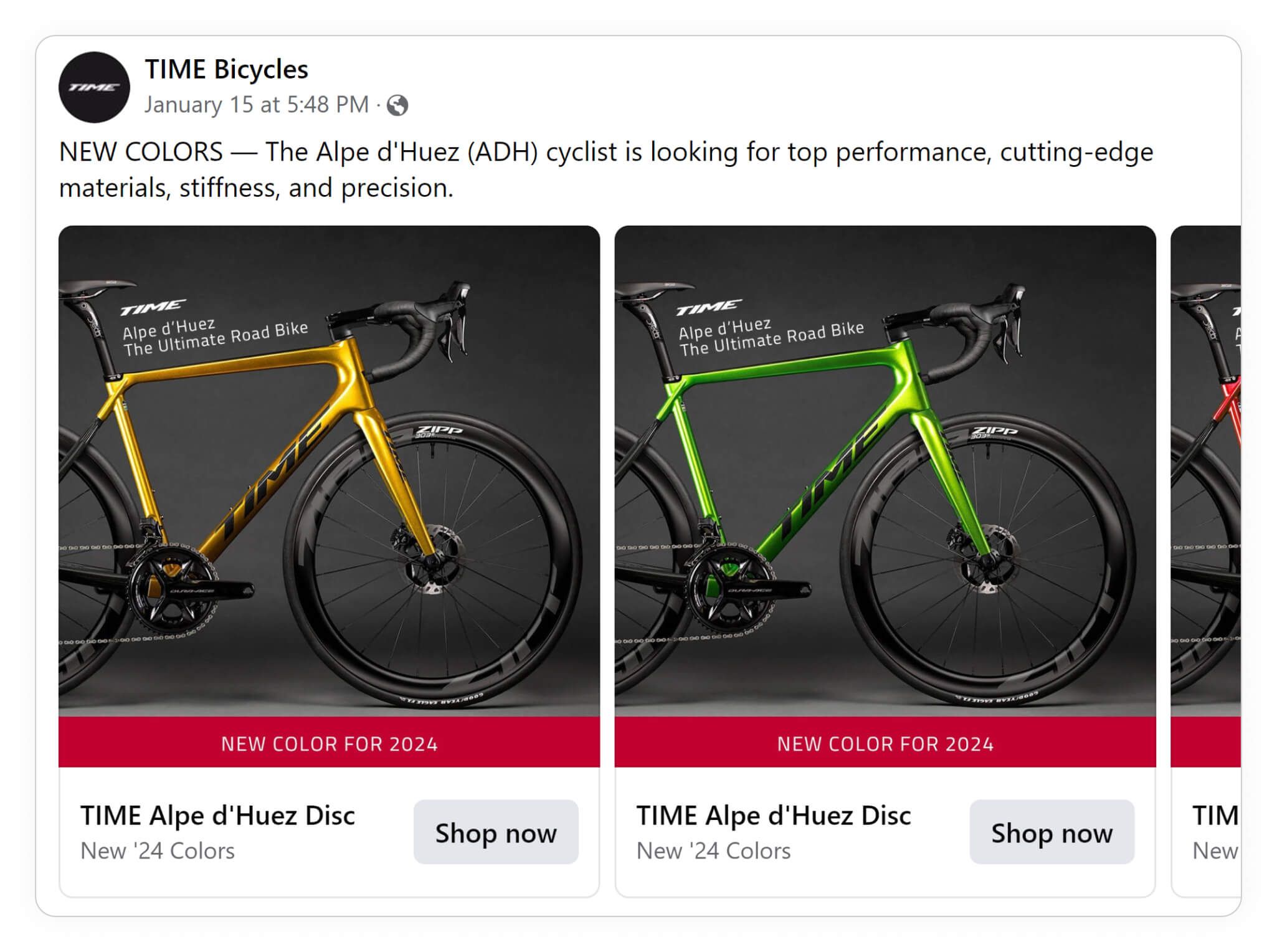
Why the disconnect? News can spark curiosity, especially among top-of-funnel audiences, but it often lacks the clarity or incentive needed to convert. If your “news” isn’t tied directly to the product’s value or urgency, it may come across as noise rather than a reason to buy.
That said, news can work well if it's product-related and relevant to your audience, like “New Spring Collection Just Dropped” or “Now Available in Your Size.” But keep it focused, and avoid pushing general company updates in your product ads.
Curious browsers might click, but meaningful clicks come from clarity, not just headlines.
Here's how highlighting news on average influence Catalog Ads:
Return On Ad Spend
-16%
Cost Per Purchase
-14%
Click Through Rate
+18%
Cost Per Click
-25%
Conversion Rate
-37%
Usage
16%
These numbers show how Catalog Ads highlighting news perform on average compared to Catalog Ads not highlighting news.
Remember that these are average numbers. For some brands, highlighting news perform better, and for other brands, highlighting news perform worse.
Learn more about highlighting news in Catalog Ads →
Showing Shipping info in your Catalog Ads
Including shipping details—like “Free Shipping” or “Ships in 2 Days”—can help reduce uncertainty for shoppers. While Catalog Ads showing shipping info see a +28% boost in conversion rate, they also experience a -18% drop in Return on Ad Spend and a -32% decrease in Cost Per Purchase. This suggests that while these ads may lead to more purchases, they aren’t always the most cost-efficient.
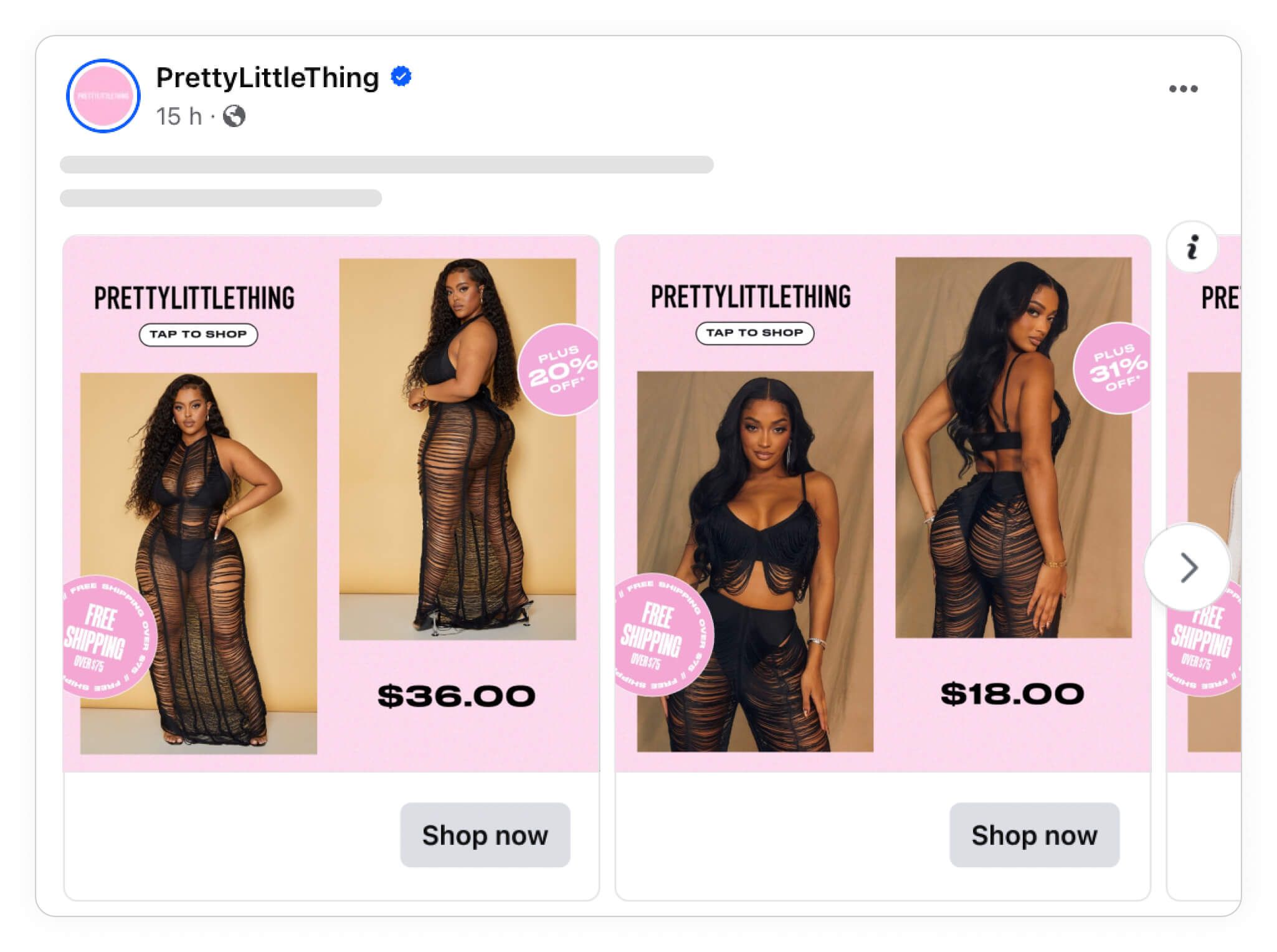
Shipping details tend to work best in the mid-to-lower funnel, when consumers are closer to making a decision and want to understand the full offer before buying. However, overemphasizing logistics early in the buyer journey may distract from what really sells the product: its benefits and appeal.
If you include shipping info, keep it short and compelling, highlighting value, not just logistics. For example, “Free 2-Day Delivery” or “Ships from the U.S.” adds both urgency and trust.
Here's how showing shipping info on average influence Catalog Ads:
Return On Ad Spend
-18%
Cost Per Purchase
-32%
Click Through Rate
-9%
Cost Per Click
+4%
Conversion Rate
+28%
Usage
16%
These numbers show how Catalog Ads showing shipping information perform on average compared to Catalog Ads not showing shipping information.
Remember that these are average numbers. For some brands, shipping info perform better, and for other brands, shipping info perform worse.
Learn more about showing shipping information in Catalog Ads →
Using Product Assets in your Catalog Ads
Product assets, like lifestyle images, 360-degree views, or even product videos, bring a unique dimension to your Catalog Ads. These visuals give customers a better understanding of how the product fits into their life or how it works. On average, Catalog Ads featuring product assets see a +34% increase in Return on Ad Spend and a +27% boost in conversion rate, though they also experience an +18% increase in Cost Per Purchase.
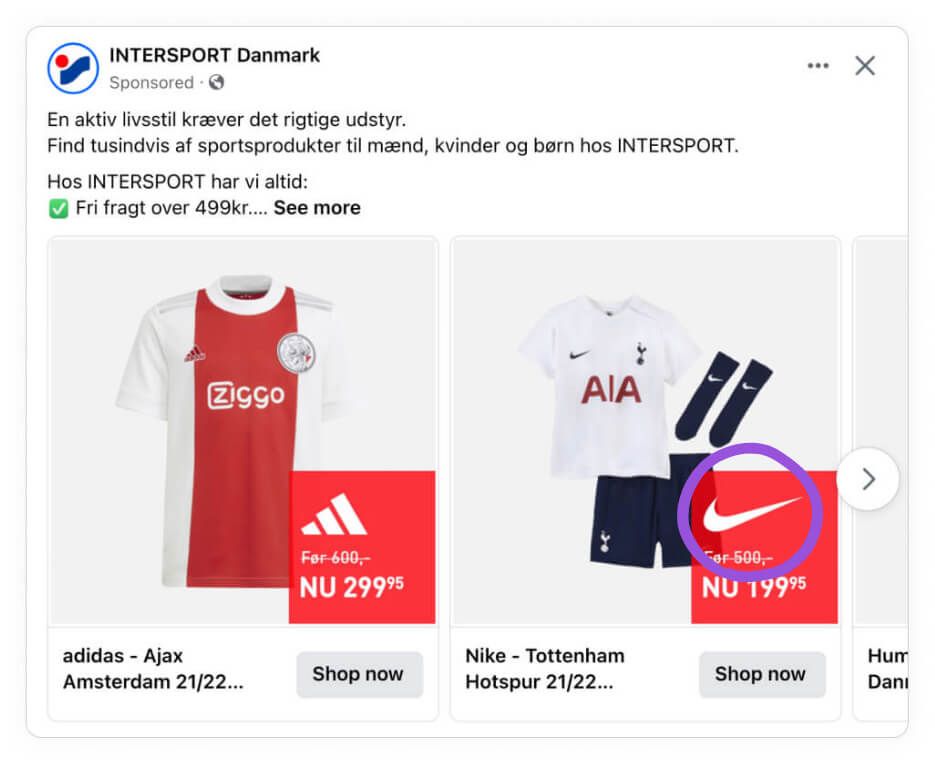
Using product assets typically works well for consumers who are already in the middle-to-bottom funnel, where they are more likely to convert if given a richer visual experience. These assets help build confidence by showing the product from different angles and contexts, helping customers visualize their purchase.
While incorporating assets can lead to higher engagement, it’s important to ensure they don’t clutter the ad or overwhelm the viewer. Focus on the most effective assets that truly showcase the product’s value.
Here's how showing product assets on average influence Catalog Ads:
Return On Ad Spend
+34%
Cost Per Purchase
+18%
Click Through Rate
-18%
Cost Per Click
+20%
Conversion Rate
+27%
Usage
10%
These numbers show how Catalog Ads showing product assets perform on average compared to Catalog Ads not showing product assets.
Remember that these are average numbers. For some brands, product assets perform better, and for other brands, product assets perform worse.
Learn more about using product assets in your Catalog Ads →
Showing Social Proof in your Catalog Ads
Social proof, such as ratings, reviews, and customer testimonials, is a powerful marketing tactic, especially for consumers who may be unfamiliar with your brand or products. When customers see that others have had positive experiences, it builds trust and increases the likelihood of conversion. Social proof tends to perform best with top-funnel ads, where customers are just beginning to learn about your brand. Top-funnel ads see a +58% improvement in Return on Ad Spend when showing social proof, while bottom-funnel ads still see a significant +35% improvement.
Social proof is one of the best-known marketing tactics, and it's more often than not effective at making your customers buy.
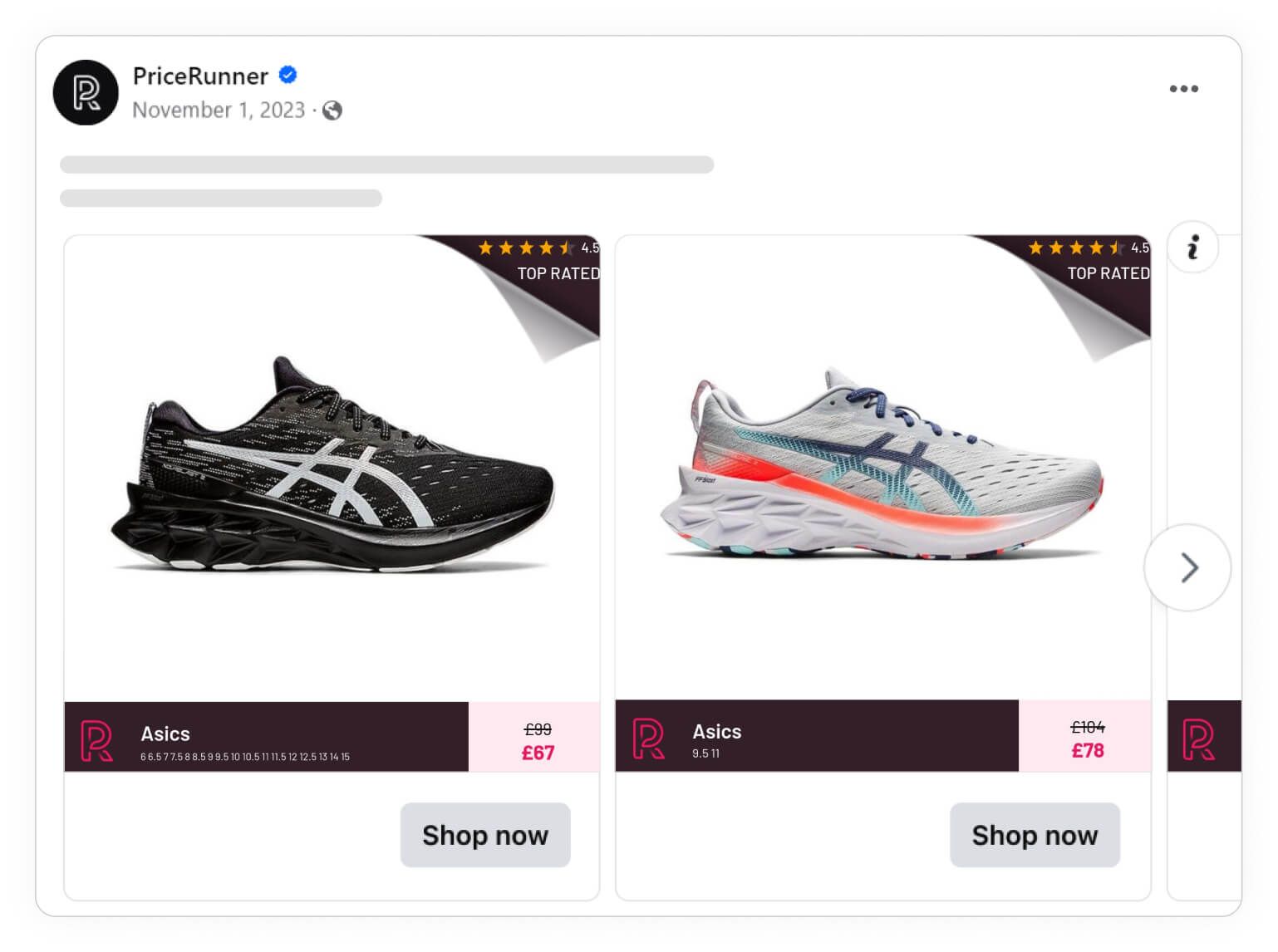
By showcasing reviews or ratings, you offer reassurance to potential buyers, especially those who may be hesitant about a purchase. However, overusing social proof or presenting it too early can backfire if not strategically placed. Finding the right balance in your ad’s design will help maximize its effectiveness.
Especially customers who don't know you or your products find a lot of trust in your social proof - the earlier in your marketing funnel customers are, the more effective Social Proof is.
- Top-funnel ads see a +58% improvement in Return on Ad Spend when showing Social Proof
- Bottom-funnel ads see a +35% improvement in Return on Ad Spend when showing Social Proof
You can learn more about showing ratings and reviews in your Catalog Ads right here.
Here's how showing social proof on average influence Catalog Ads:
Return On Ad Spend
+35%
Cost Per Purchase
+39%
Click Through Rate
-31%
Cost Per Click
+39%
Conversion Rate
+47%
Usage
11%
These numbers show how Catalog Ads showing social proof perform on average compared to Catalog Ads not showing social proof.
Remember that these are average numbers. For some brands, social proof perform better, and for other brands, social proof perform worse.
Learn more about using social proof in your Catalog Ads →
Showing Product Brands in your Catalog Ads
Including brand names in your Catalog Ads can significantly impact performance, especially when the brand is well-known or trusted by consumers. On average, showing brand names leads to a +49% improvement in Return on Ad Spend, making it a smart move for retailers who want to leverage brand recognition. Top-funnel ads benefit most from showcasing brand names, seeing increased Click Through Rates (+25%) and reduced Cost Per Purchase (-20%). However, Conversion Rates may dip slightly (-23%), as some shoppers may be more focused on product details than the brand itself.
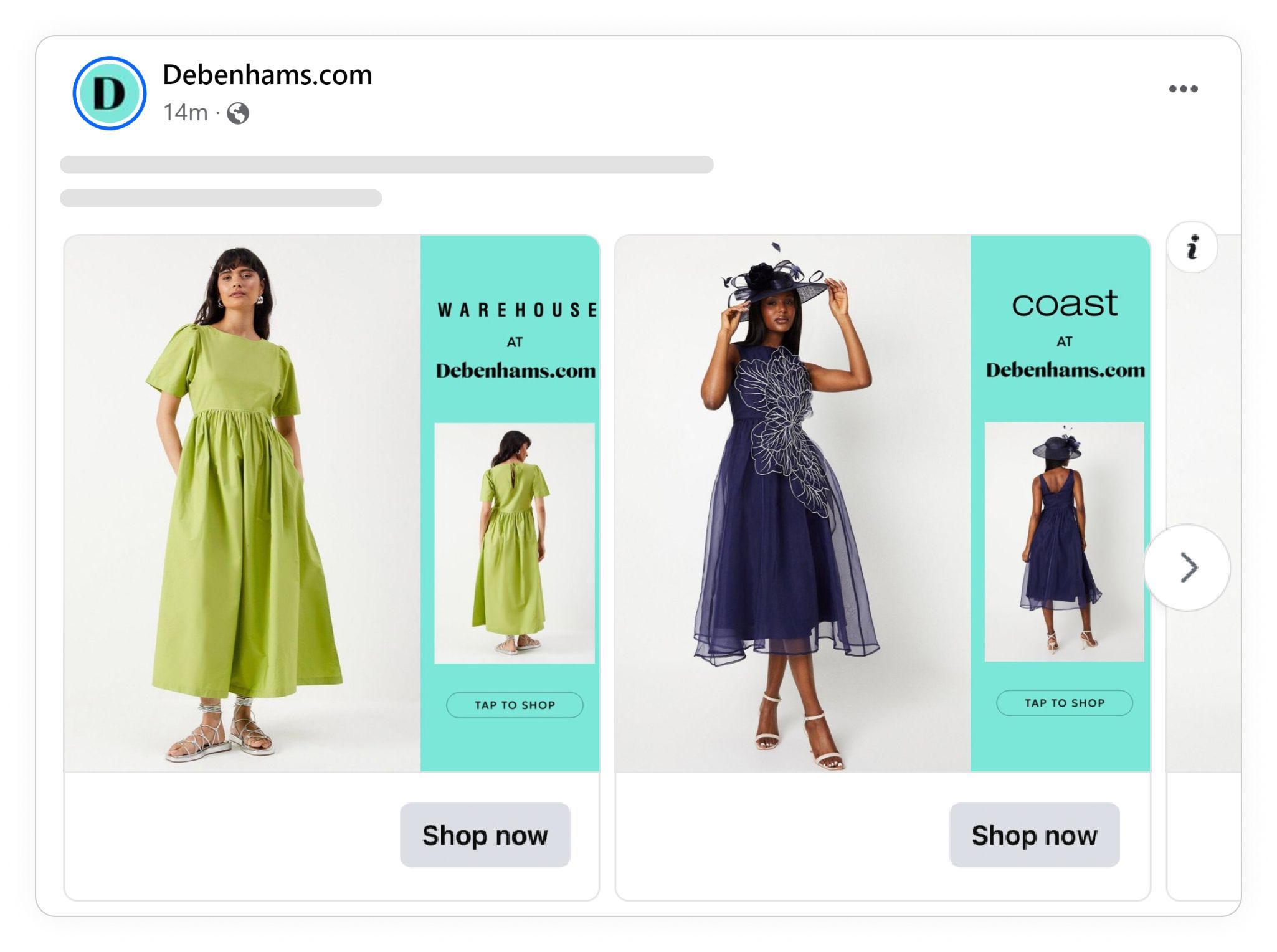
Incorporating brand names works best when the brand has a strong reputation. For less-known brands, it might not yield the same results, so be mindful of how the brand name is presented in your ad to avoid overcrowding or distracting from the main product features.
Here's how showing brand names on average influence Catalog Ads:
Return On Ad Spend
+49%
Cost Per Purchase
-20%
Click Through Rate
+25%
Cost Per Click
-18%
Conversion Rate
-23%
Usage
6%
These numbers show how Catalog Ads showing brand names perform on average compared to Catalog Ads not showing brand names.
Remember that these are average numbers. For some retailers, brand names perform better, and for other retailers, brand names perform worse.
Learn more about showing brand names in your Catalog Ads →
Showing Custom_labels in your Catalog Ads
As consumers become more familiar with your products, they tend to seek out more specific and tailored information. This is where Custom_labels shine, offering a way to provide custom attributes that resonate with more knowledgeable buyers. Custom labels are especially effective in the bottom funnel, where consumers are closer to making a purchase and are eager to dig into product details.
The more consumers learn about you and your products, the more nerdy they typically want to become - and we see this very clearly when looking at Custom_labels, the best way to show custom information in Catalog Ads.

Top-funnel ads see a moderate improvement in Return on Ad Spend (+29%) when using custom labels, but bottom-funnel ads see a +73% improvement. This demonstrates that the more consumers know about your brand and products, the better Custom_labels can help convert them. Custom labels can highlight product features, availability, or any other custom attribute that speaks directly to a consumer’s needs. While showing custom information increases Conversion Rates (+102%), it's essential to consider the balance between detailed information and keeping the ad visually engaging to prevent overwhelming the audience.
The further down you are in your marketing funnel, the better nerdy and custom information will perform.
- Top-funnel ads see a +29% improvement in Return on Ad Spend when showing Custom labels
- Bottom-funnel ads see a +73% improvement in Return on Ad Spend when showing Custom labels
You can learn more about showing custom attributes and features in your Catalog Ads here .
Here's how showing custom labels on average influence Catalog Ads:
Return On Ad Spend
+73%
Cost Per Purchase
-34%
Click Through Rate
-17%
Cost Per Click
+2%
Conversion Rate
+102%
Usage
7%
These numbers show how Catalog Ads showing custom labels perform on average compared to Catalog Ads not showing custom labels.
Remember that these are average numbers. For some brands, custom labels perform better, and for other brands, custom labels perform worse.
Learn more about showing custom attributes and features in your Catalog Ads →
Showing Categories in your Catalog Ads
Showing product categories in your Catalog Ads can help streamline the customer’s journey by providing more structure and context to your offering. When consumers can immediately understand what category a product belongs to, it can enhance their shopping experience and make it easier for them to find exactly what they're looking for.
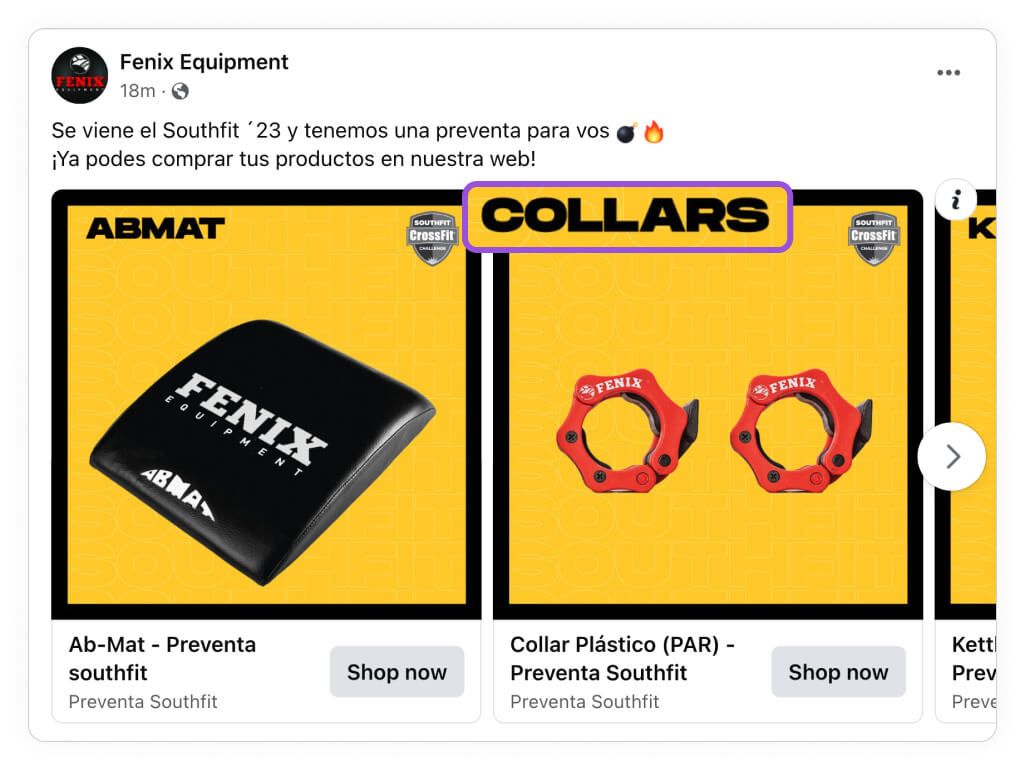
This tactic shows strong results, especially as you move further down the marketing funnel. Return on Ad Spend increases dramatically by +105% when product categories are displayed, while Conversion Rates experience a +186% improvement. However, you should keep in mind that the Cost Per Purchase can be -32% lower and the Click Through Rate can decrease by -34%, which suggests that showing categories works best when you’re targeting an audience that's already somewhat familiar with your brand.
Here's how showing product categories on average influence Catalog Ads:
Return On Ad Spend
+105%
Cost Per Purchase
-32%
Click Through Rate
-34%
Cost Per Click
+28%
Conversion Rate
+186%
Usage
4%
These numbers show how Catalog Ads showing categories perform on average compared to Catalog Ads not showing categories.
Remember that these are average numbers. For some brands, categories perform better, and for other brands, categories perform worse.
Learn more about showing categories in your Catalog Ads →
Showing Product Descriptions in Catalog Ads
Including product descriptions in your Catalog Ads can be an excellent way to give consumers more context about the features, benefits, or uniqueness of your products. While this tactic often performs well in terms of generating interest and improving Click Through Rates (+30%), it can have mixed results in other areas, such as Conversion Rates, which can drop by -65%.
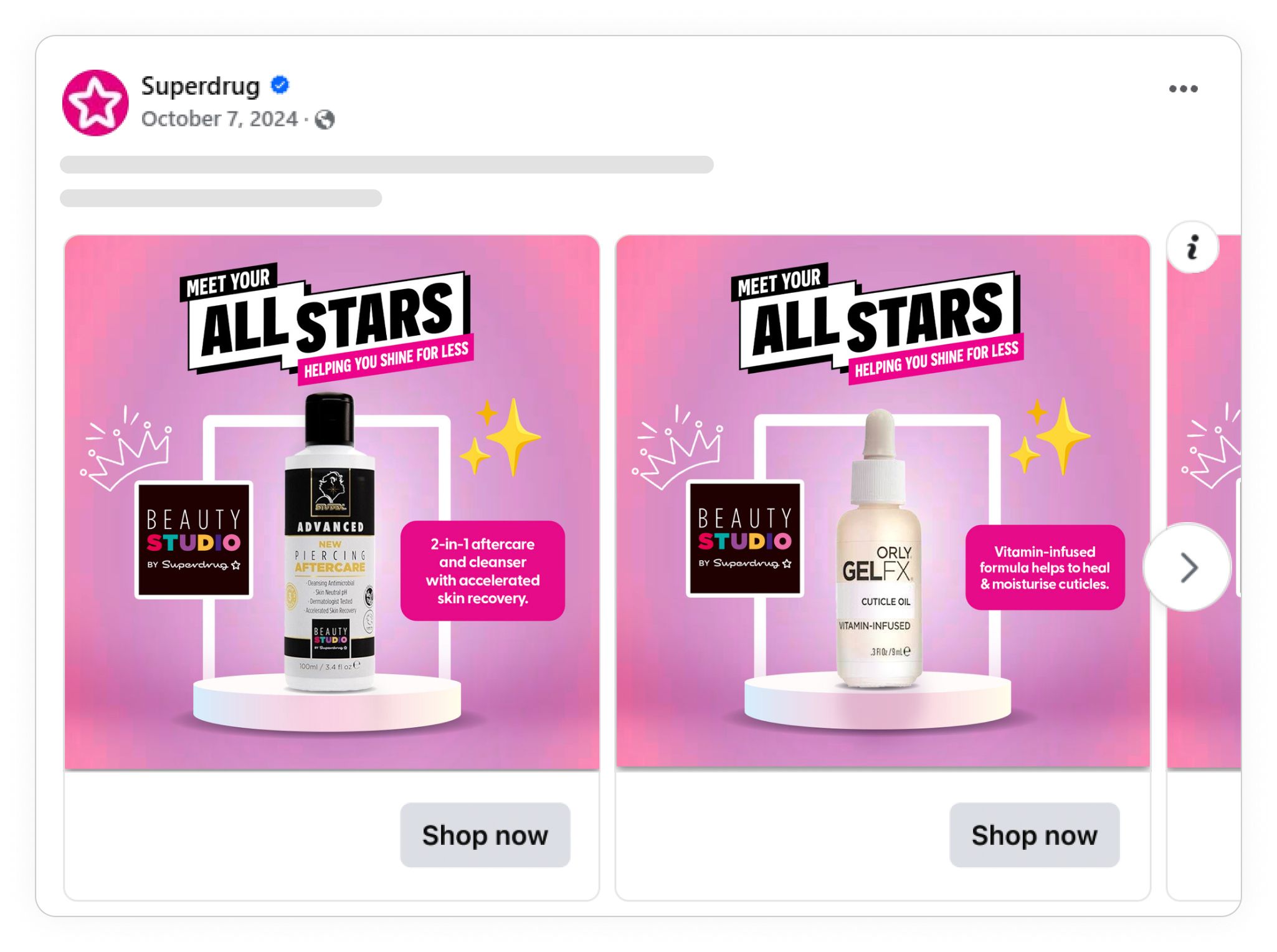
Here's how showing descriptions on average influence Catalog Ads:
Return On Ad Spend
+88%
Cost Per Purchase
+24%
Click Through Rate
+30%
Cost Per Click
-9%
Conversion Rate
-65%
Usage
0%
Interestingly, Return on Ad Spend (+88%) and Cost Per Purchase (+24%) both show significant improvements, suggesting that, when used strategically, descriptions can provide a better understanding of the product, especially for consumers in the middle or lower parts of the funnel. However, the challenge is to balance this additional information without overwhelming the potential buyer.
Since descriptions are used less frequently (0% usage), you may want to experiment with this tactic to see how it works for your brand.
These numbers show how Catalog Ads showing descriptions perform on average compared to Catalog Ads not showing descriptions.
Remember that these are average numbers. For some brands, descriptions perform better, and for other brands, descriptions perform worse.
Learn more about showing product descriptions in your Catalog Ads →
Bookmark this page by pressing ctrl + D / cmd + D, or by clicking the star icon in your URL bar ⭐️.
In bottom-funnel and retargeting campaigns, small design decisions can lead to big performance gains. By leveraging tactics like showing prices, discounts, product names, or even subtle trust signals like logos and social proof, you’re not just filling space — you’re answering the final questions a shopper has before they buy.
The data proves it: these details consistently improve ROAS, lower cost per purchase, and increase conversion rates. But more importantly, they help your ads feel more relevant, clear, and persuasive to an audience that’s already on the edge of converting.
Don’t leave your success up to guesswork. Use these insights to make informed, data-backed decisions that move the needle at the most critical stage of the customer journey.
When the goal is to seal the deal, well-designed Catalog Ads can be your highest-converting tool. Now it's time to put these tactics into practice and turn consideration into conversion.
